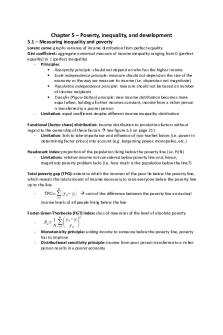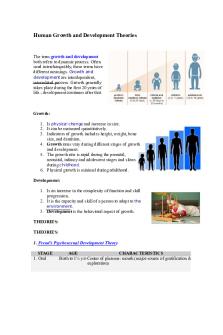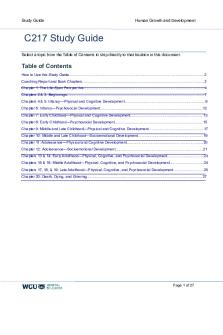Growth & Development PDF

| Title | Growth & Development |
|---|---|
| Course | Economics of Developing Countries |
| Institution | University of Bristol |
| Pages | 4 |
| File Size | 121.3 KB |
| File Type | |
| Total Downloads | 102 |
| Total Views | 171 |
Summary
Notes from Economic Development by Todaro and Smith Chapter 1 ● Subsistence Economy - An economy in which production is mainly for personal consumption and the standard of living yields little more than basic necessities of life; food, shelter and clothing. ● Development - The process of improving t...
Description
Notes from Economic Development by Todaro and Smith Chapter 1 ●
Subsistence Economy - An economy in which production is mainly for personal consumption and the standard of living yields little more than basic necessities of life; food, shelter and clothing.
●
Development - The process of improving the quality of all human lives and capabilities by raising people’s level of living, self-esteem and freedom.
●
Traditional economies - An approach to economics that emphasizes utility, profit maximization, market efficiency and determination of equilibrium.
●
Political economies - The attempt to merge economic analysis with practical politics with a special emphasis on the role of power in economic decision making.
●
Development economies - The study of how economies are transformed from stagnation to growth and from low income to high income status and overcome problems of absolute poverty.
●
GNI - The total domestic and foreign output claimed by residents of a country. (GDP + factor incomes accruing to residents from abroad - the income earned in the domestic economy accruing to persons abroad). Traditional Economic Measures
1. Achieving sustained rates of growth of income per capita - for a nation to expand its output at a rate faster than the growth rate of a population. 2. Gross National Income (GNI) are used to measure how much of real goods and services are available to the average citizen for consumption or investment (overall economic well being of a population). Amartya Sen’s “Capability” Approach ● Argues that the “capability to function” is what really matters for status as a poor or non poor person. ● What matters for well-being is not just the characteristics of commodities consumed, as in the utility approach, but what use the consumer can and does make of commodities. 1. 5 sources of disparity between real incomes and actual advantages a) Personal heterogeneities - those connected with disability, illness, age or gender b) Environmental disabilities - heating and clothing requirements in the cold, infectious diseases in the tropics, impact of pollution c) Vacations in social climate - the prevalence of crime and violence and “social capital”. d) Distribution within the family - Income received in the family is the basic unit of
shred consumption e) Differences in rational perspectives. ● ●
Capabilities - The freedom that people have, given their personal features and their command over commodities. (Sen) Real income is essential, but to convert the characteristics of commodities into functionings, in most important cases, surely requires health and education as well as income.
❖ The government of Bhutan - “gross national happiness: rather than GNI as its measure of development progress. Three Core Values of Development - Sustenance, Self-esteem and Freedom ★ Sustenance - The ability to meet basic needs The basic goods and services, such as food, clothing and shelter that are necessary to sustain an average human being at the bare minimum level of living. The absence or critically short supply could lead to “absolute underdevelopment”. Raising per capita incomes, the elimination of absolute poverty, greater employment opportunities and lessening income inequalities therefore constitute the necessary but not the sufficient conditions for development. ★
Self-Esteem - To Be a Person A sense of worth and self-respect, of not being used as a tool by others for their own ends. The feeling of worthiness that a society enjoys when its social, political and economic systems and institutions promote human values such as respect, dignity, integrity and self-determination.
★ Freedom from Servitude - To be able to choose A situation in which a society has at its disposal a variety of alternatives from which to satisfy its wants and individuals enjoy real choices according to their preferences. The 3 Objectives of Development 1. To increase the availability and widen the distribution of basic life-sustaining goods such as food, shelter, health and protection. 2. To raise levels of living: in addition to higher income, providing more jobs, better education, and greater attention to cultural and human value. 3. To expand the range of economic and social choices. The Millennium Development Goals A set of 8 goals adopted by the UN in 2000: to eradicate extreme poverty and hunger, achieve universal primary education, promote gender equality and empower women, reduce child mortality, improve maternal health, combat HIV/AIDS, malaria and other diseases, ensure
environmental sustainability and develop a global partnership for development. The goals were assigned specific targets to be achieved by 2015. Goals 1. Eradicate extreme poverty and hunger
Targets ●
Reduce by half the proportion of people living on less than $1 a day. ● Reduce by half the proportion of people who suffer from hunger.
2. Achieve universal primary education
●
Ensure that all boys and girls complete a full course of primary schooling.
3. Promote gender equality and empower women
●
Eliminate gender disparity in primary and secondary education, preferably by 2005, and at all levels by 2015.
4. Reduce child mortality
●
Reduce by two-thirds the mortality rate among children under 15.
5. Improve mental health
●
Reduce by three-quarters the maternal mortality ratio.
6. Combat HIV/AIDS, malaria and other diseases
●
Halt and begin to reverse the spread of HIV/AIDS Halt and begin to reverse the incidence of malaria and other major diseases.
●
7. Ensure environmental sustainability
●
Integrate the principles of sustainable development into country policies and programs; reverse loss of environmental resources ● Reduce by half the proportion of people without sustainable access to safe drinking water. ● Achieve significant improvement in lives of at least 100 million slum dwellers by 2020.
8. Develop a global partnership for development
●
●
Develop further an open, rule-based, predictable, nondiscriminatory trading and financial system; includes a commitment to good governance, development and poverty reduction both nationally and internationally. Address the special needs of the least developed countries; includes tariff and quota free access for least
● ●
●
●
●
developed countries’ exports; enhanced program of debt relief for heavily indebted poor countries (HIPCs) and cancellation of official bilateral debt; and more generous official development assistance (ODA) for countries committed to poverty reduction. Address the special needs of landlocked countries and small island developing states. Deal comprehensively with the debt problems of developing countries through national and international measures in order to make debt sustainable in the long term. In cooperation with developing countries, develop and implement strategies for decent and productive work for youth. In cooperation with pharmaceutical companies, provide access to affordable essential drugs in developing countries. In cooperation with the private sector, make available the benefits of new technologies, especially information and communications....
Similar Free PDFs

Growth & Development
- 4 Pages

Growth and Development Notes
- 10 Pages

Human growth and development
- 46 Pages

Growth and development chart
- 9 Pages

Growth and Development CH01 exam
- 40 Pages

Growth and Development CH03 TB
- 41 Pages
Popular Institutions
- Tinajero National High School - Annex
- Politeknik Caltex Riau
- Yokohama City University
- SGT University
- University of Al-Qadisiyah
- Divine Word College of Vigan
- Techniek College Rotterdam
- Universidade de Santiago
- Universiti Teknologi MARA Cawangan Johor Kampus Pasir Gudang
- Poltekkes Kemenkes Yogyakarta
- Baguio City National High School
- Colegio san marcos
- preparatoria uno
- Centro de Bachillerato Tecnológico Industrial y de Servicios No. 107
- Dalian Maritime University
- Quang Trung Secondary School
- Colegio Tecnológico en Informática
- Corporación Regional de Educación Superior
- Grupo CEDVA
- Dar Al Uloom University
- Centro de Estudios Preuniversitarios de la Universidad Nacional de Ingeniería
- 上智大学
- Aakash International School, Nuna Majara
- San Felipe Neri Catholic School
- Kang Chiao International School - New Taipei City
- Misamis Occidental National High School
- Institución Educativa Escuela Normal Juan Ladrilleros
- Kolehiyo ng Pantukan
- Batanes State College
- Instituto Continental
- Sekolah Menengah Kejuruan Kesehatan Kaltara (Tarakan)
- Colegio de La Inmaculada Concepcion - Cebu








![[Topic 4] Difference between Growth and Development](https://pdfedu.com/img/crop/172x258/og2vxwpzno34.jpg)
